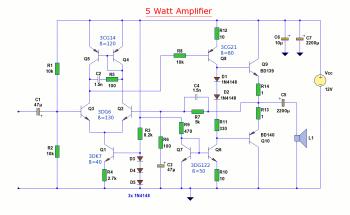Input Stage
The input stage consists of Q1 through Q5 and 3 diodes. The differential pair is biased by Q1, R3, R4, D3, D4, and D5. The biased current is set to 1 mA. Q4 and Q5 form a current mirror as the active load for the differential pair, and the output is taken out single-endedly from the collector of Q2. The open loop gain of the input stage is more than 60dB.
Second Stage
Q8 act as a common-emitter amplifier driving the output stage. Current mirror formed by Q6 and Q7 serve both biasing current source and active load for Q8. The open loop gain of the second stage is about 40dB. Q6 and Q7 are mounted together inside the blue tube to provide thermal compensation to each other.
Output Stage
The complimentary pair BD139/140 is biased by D1, D2, and R10. Adjusting the value of R10 can yield the desired quiescent current. R13 and R14 prevent thermal run-away of the complementary pair. DC voltage at the output is always half the power supply.
Feedback
The feedback network consists of R6, R5, C3 and C4. The overall gain is about the ratio of R6 to R5. C4 provides lead compensation; C3 provides DC-blocking.
Frequency Response
The cut-off frequency is determined at the upper end by C2, R5, and C4, and at the lower end by C1, C3, and C5.
Power
Power supply voltage 12V, 5W for a 4 ohm speaker, 3W for an 8 ohm speaker.
5W audio amplifier circuit page source: http://www.zen22142.zen.co.uk/Circuits/Audio/5w12v_amp.htm
About Audio Amplifier
An audio amplifier is an electronic amplifier that amplifies low-power audio signals (signals composed primarily of frequencies between 20 - 20 000 Hz, the human range of hearing) to a level suitable for driving loudspeakers and is the final stage in a typical audio playback chain.
The preceding stages in such a chain are low power audio amplifiers which perform tasks like pre-amplification, equalization, tone control, mixing/effects, or audio sources like record players, CD players, and cassette players. Most audio amplifiers require these low-level inputs to adhere to line levels.
While the input signal to an audio amplifier may measure only a few hundred microwatts, its output may be tens, hundreds, or thousands of watts. More explanation about power audio amplifier can be found at wikipedia.org
An audio amplifier is an electronic amplifier that amplifies low-power audio signals (signals composed primarily of frequencies between 20 - 20 000 Hz, the human range of hearing) to a level suitable for driving loudspeakers and is the final stage in a typical audio playback chain.
The preceding stages in such a chain are low power audio amplifiers which perform tasks like pre-amplification, equalization, tone control, mixing/effects, or audio sources like record players, CD players, and cassette players. Most audio amplifiers require these low-level inputs to adhere to line levels.
While the input signal to an audio amplifier may measure only a few hundred microwatts, its output may be tens, hundreds, or thousands of watts. More explanation about power audio amplifier can be found at wikipedia.org
This is a video tutorial about how to a very simple audio amplifier based on the LM386 amplifier chip. It can be built for less than $20 (or might be less than $8 in some countries) and used to amplify any low level audio signal including a guitar, bass or mp3 player.
Watch the video:

No comments:
Post a Comment